Solar eclipse of January 14, 1945
| Solar eclipse of January 14, 1945 | |
|---|---|
| Type of eclipse | |
| Nature | Annular |
| Gamma | −0.4937 |
| Magnitude | 0.997 |
| Maximum eclipse | |
| Duration | 15 s (0 min 15 s) |
| Coordinates | 51°06′S 110°18′E / 51.1°S 110.3°E |
| Max. width of band | 12 km (7.5 mi) |
| Times (UTC) | |
| Greatest eclipse | 5:01:43 |
| References | |
| Saros | 140 (25 of 71) |
| Catalog # (SE5000) | 9386 |
An annular solar eclipse occurred on Sunday, January 14, 1945. A solar eclipse occurs when the Moon passes between Earth and the Sun, thereby totally or partly obscuring the image of the Sun for a viewer on Earth. An annular solar eclipse occurs when the Moon's apparent diameter is smaller than the Sun's, blocking most of the Sun's light and causing the Sun to look like an annulus (ring). An annular eclipse appears as a partial eclipse over a region of the Earth thousands of kilometres wide. Annularity was visible from Eastern Cape in South Africa, and northeastern Tasmania Island and Furneaux Group in Australia.
Observations[edit]
During this eclipse, the apex of the moon's umbral cone was close to the Earth's surface, and the magnitude was large. The edges of the moon and the sun were close to each other as seen from the Earth. Baily's beads on the lunar limb, which are usually only visible during a total solar eclipse, could also be seen.
Related eclipses[edit]
Solar eclipses 1942–1946[edit]
This eclipse is a member of a semester series. An eclipse in a semester series of solar eclipses repeats approximately every 177 days and 4 hours (a semester) at alternating nodes of the Moon's orbit.[1]
| Solar eclipse series sets from 1942 to 1946 | ||||||
|---|---|---|---|---|---|---|
| Ascending node | Descending node | |||||
| Saros | Map | Gamma | Saros | Map | Gamma | |
| 115 | August 12, 1942 Partial |
–1.52444 | 120 | February 4, 1943 Total |
0.87335 | |
| 125 | August 1, 1943 Annular |
–0.80410 | 130 | January 25, 1944 Total |
0.20246 | |
| 135 | July 20, 1944 Annular |
–0.03135 | 140 | January 14, 1945 Annular |
–0.49366 | |
| 145 | July 9, 1945 Total |
0.73557 | 150 | January 3, 1946 Partial |
–1.23918 | |
| 155 | June 29, 1946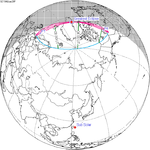 Partial |
1.43612 | ||||
Saros 140[edit]
It is a part of Saros cycle 140, repeating every 18 years, 11 days, containing 71 events. The series started with partial solar eclipse on April 16, 1512. It contains total eclipses from July 21, 1656 through November 9, 1836, hybrid eclipses from November 20, 1854 through December 23, 1908, and annular eclipses from January 3, 1927 through December 7, 2485. The series ends at member 71 as a partial eclipse on June 1, 2774. The longest duration of totality was 4 minutes, 10 seconds on August 12, 1692.
| Series members 23–53 occur between 1901 and 2450: | ||
|---|---|---|
| 23 | 24 | 25 |
 Dec 23, 1908 |
 Jan 3, 1927 |
 Jan 14, 1945 |
| 26 | 27 | 28 |
 Jan 25, 1963 |
 Feb 4, 1981 |
 Feb 16, 1999 |
| 29 | 30 | 31 |
 Feb 26, 2017 |
 Mar 9, 2035 |
 Mar 20, 2053 |
| 32 | 33 | 34 |
 Mar 31, 2071 |
 Apr 10, 2089 |
 Apr 23, 2107 |
| 35 | 36 | 37 |
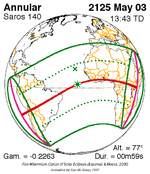 May 3, 2125 |
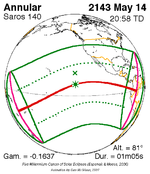 May 14, 2143 |
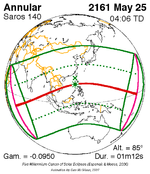 May 25, 2161 |
| 38 | 39 | 40 |
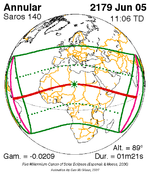 Jun 5, 2179 |
 Jun 15, 2197 |
 Jun 28, 2215 |
| 41 | 42 | 43 |
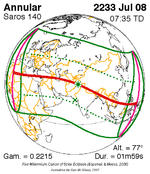 Jul 8, 2233 |
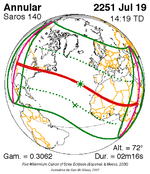 Jul 19, 2251 |
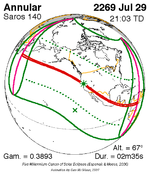 Jul 29, 2269 |
| 44 | 45 | 46 |
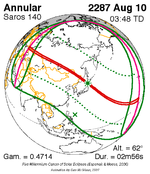 Aug 10, 2287 |
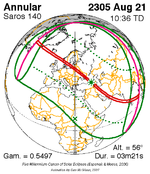 Aug 21, 2305 |
 Sep 1, 2323 |
| 47 | 48 | 49 |
 Sep 12, 2341 |
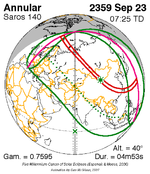 Sep 23, 2359 |
 Oct 3, 2377 |
| 50 | 51 | 52 |
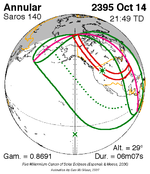 Oct 14, 2395 |
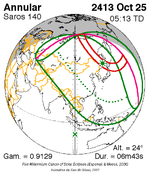 Oct 25, 2413 |
 Nov 5, 2431 |
| 53 | ||
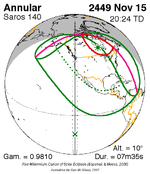 Nov 15, 2449 | ||
Notes[edit]
- ^ van Gent, R.H. "Solar- and Lunar-Eclipse Predictions from Antiquity to the Present". A Catalogue of Eclipse Cycles. Utrecht University. Retrieved 6 October 2018.
References[edit]
- Earth visibility chart and eclipse statistics Eclipse Predictions by Fred Espenak, NASA/GSFC




